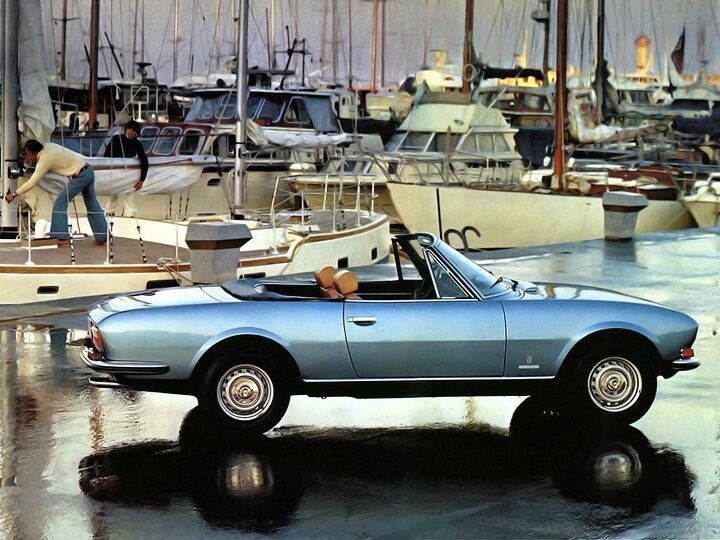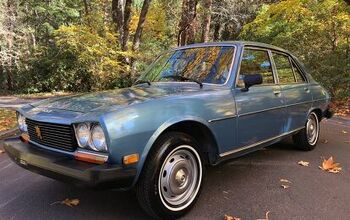Rare Rides: Luxurious and Stylish, a Peugeot 504 Cabriolet From 1975

Rare Rides featured the no-nonsense sedan version of the 504 some time ago, an example which was the same model year as today’s cabriolet. But while the sedan 504 was targeted to the no-nonsense family car buyer, the cabriolet was considerably more upmarket.
Come along as we learn some more about the most exciting version of Peugeot’s long-lived 504.
The 504 was introduced in 1968 as a replacement for the notoriously reliable 404. There was quite a bit of overlap in 404 and 504 production, as the 404 remained in production through 1975 in the European market, 1980 in South America, and 1991 in Kenya.
At its debut, the rear-drive 504 was available only in sedan guise. Its initial launch was delayed due to general upheaval in France in politics and production circa spring of 1968. The car’s launch was delayed until the fall, at which point the 504 started winning awards and praise for generally all of its characteristics.
The next bodies to debut were the coupe and cabriolet versions, introduced in spring 1969 at Geneva. The initial 1.8-liter gasoline engines in two-door 504s made the same 79 horsepower as in the sedan, but had a revised drive ratio to give a higher road speed at low RPMs. All two-door examples had injection as standard, where it was optional at sedan level.
504’s range expanded in 1970 to include a wagon (Break) and a pickup truck. Engines changed too, where base engine was a new 2.0-liter inline-four good for 96 horses, or 105 if fuel injected. Another diesel also appeared, which at 2.1 liters was larger than the initial 1.8 (which remained available). Ford later purchased the 2.1 diesel for use in the European Granada, because it couldn’t be bothered to develop its own.
More engine changes occurred in 1974 with the debut of an all-new high-tech PRV V6, the jointly-developed engine from the good people at Peugeot, Renault, and Volvo. 2.7 liters in displacement, the innovative engine put out 136 horsepower, and increased top speed to 116 miles per hour. The V6 was limited in availability to the more expensive coupe and cabriolet, and replaced all four-cylinder power in those examples. The exclusivity and high price was short-lived though, as in 1978 four-pot engines returned to coupe and cabriolet per customer demand.
French 504 production slowed down after 1979 as the 505 was ready to replace it, but trickled through 1983. Elsewhere, Argentina enjoyed 504 through 1999, Kenya until 2004, and Nigeria until 2006. A nice, tidy run of 38 years for the 504.
It’s from the V6 era which today’s Rare Ride hails. Brown over tan, the five-speed manual cabriolet wears its Pininfarina badges proudly, and features a luxurious interior with plenty of burled wood. Four people can ride in exclusive 504 cabriolet comfort for $84,000.
[Images: Peugeot]

Interested in lots of cars and their various historical contexts. Started writing articles for TTAC in late 2016, when my first posts were QOTDs. From there I started a few new series like Rare Rides, Buy/Drive/Burn, Abandoned History, and most recently Rare Rides Icons. Operating from a home base in Cincinnati, Ohio, a relative auto journalist dead zone. Many of my articles are prompted by something I'll see on social media that sparks my interest and causes me to research. Finding articles and information from the early days of the internet and beyond that covers the little details lost to time: trim packages, color and wheel choices, interior fabrics. Beyond those, I'm fascinated by automotive industry experiments, both failures and successes. Lately I've taken an interest in AI, and generating "what if" type images for car models long dead. Reincarnating a modern Toyota Paseo, Lincoln Mark IX, or Isuzu Trooper through a text prompt is fun. Fun to post them on Twitter too, and watch people overreact. To that end, the social media I use most is Twitter, @CoreyLewis86. I also contribute pieces for Forbes Wheels and Forbes Home.
More by Corey Lewis
Latest Car Reviews
Read moreLatest Product Reviews
Read moreRecent Comments
- Redapple2 I think I ve been in 100 plants. ~ 20 in Mexico. ~10 Europe. Balance usa. About 1/2 nonunion. I supervised UAW skilled trades guys at GM Powertrain for 6 years. I know the answer.PS- you do know GM products - sales weighted - average about 40% USA-Canada Content.
- Jrhurren Unions and ownership need to work towards the common good together. Shawn Fain is a clown who would love to drive the companies out of business (or offshored) just to claim victory.
- Redapple2 Tadge will be replaced with a girl. Even thought -today- only 13% of engineer -newly granted BS are female. So, a Tadge level job takes ~~ 25 yrs of experience, I d look at % in 2000. I d bet it was lower. Not higher. 10%. (You cannot believe what % of top jobs at gm are women. @ 10%. Jeez.)
- Redapple2 .....styling has moved into [s]exotic car territory[/s] tortured over done origami land. There; I fixed it. C 7 is best looking.
- TheEndlessEnigma Of course they should unionize. US based automotive production component production and auto assembly plants with unionized memberships produce the highest quality products in the automotive sector. Just look at the high quality products produced by GM, Ford and Chrysler!






































Comments
Join the conversation
PRV V6 engines has bad reputation (head and cam problems where quit common). Later ones, specially fuel injection models are much better, still parts are very costly and there is lack some engine parts. PRV V6 engine was developed jointly by Peugeot, Renault and Volvo. It was widely used in french cars, Alpine, Talbot, Citroen XM and most common cars like Renault 25/30, Peugeot 604/605 and Volvo 260/760 -series. And do not forget DeLorean. PRV V6 manufacturer was in France "Française de Mécanique" -company. Engine was in production 1974-1998.
I've long been a fan of these (it's a shame we never got them in the US), and others mentioned, there's a definite resemblance to Pininfarina's Fiat 124 Sport and 124 Spyder designs. I'd take one of each of the earlier examples, before the PRV V6 came along.